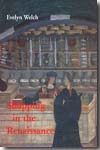Shopping in the Renaissance
consumer cultures in Italy, 1400-1600
- ISBN: 9780300159851
- Editorial: Yale University Press
- Fecha de la edición: 2009
- Lugar de la edición: New Haven. Estados Unidos de Norteamérica
- Encuadernación: Rústica
- Medidas: 23 cm
- Nº Pág.: 401
- Idiomas: Inglés

Shopping was as important in the Renaissance as it is today. This fascinating, timely and original book breaks new ground in the area of Renaissance material culture, focussing on the marketplace in its various aspects, ranging from middle-class to courtly consumption and from the provision of foodstuffs to the acquisition of antiquities and holy relics. It asks how men and women of different social classes went out into the streets, squares and shops to buy the goods they needed and wanted on a daily or on a once-in-a-lifetime basis during the Renaissance period. When could they shop and where could they shop? Did they send servants, or were deliveries made to their door? How did they know when they were getting good value or when they were being cheated? Could they return items that were not satisfactory? Drawing on a richly detailed mixture of archival, literary and visual sources, she exposes the fears, anxieties and social possibilities of the Renaissance marketplace. Thereafter, Welch looks at the impact these attitudes had on the developing urban spaces of Renaissance cities, before turning to more transient forms of sales such as fairs, auctions and lotteries. In the third section, she examines the consumers themselves, asking how the mental, verbal and visual images of the market shaped the business of buying and selling. Who actually undertook the different types of shopping required by a Renaissance household? How did life cycles, lifestyles and the rhetoric of honour, familial dignity and pride affect the way provisioning and purchasing were undertaken? Finally, the book explores two seemingly very different types of commodities: antiquities and indulgences, both of which posed dramatic challenges to contemporary notions of market value and to the concept of commodification itself. This rich and rewarding book makes enthralling reading, with new information and new perspectives on virtually every page. A wide range of primary sources are skilfully and su






